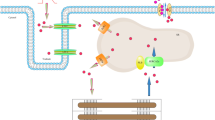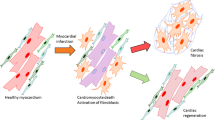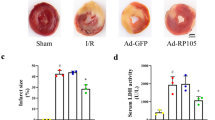Abstract
To examine the intracellular signaling mechanism of NO in ischemic myocardium, isolated working rat hearts were made ischemic for 30 min followed by 30 min of reperfusion. A separate group of hearts were pre-perfused with 3 mM L-arginine in the presence or absence of 650 μM of protoporphyrin, a heme oxygenase inhibitor for 10 min prior to ischemia. The release of NO was monitored using an on-line amperometric sensor placed into the right atrium. The aortic flow and developed pressure were examined to determine the effects of L-arginine on ischemic/reperfusion injury. Induction for the expression of heme oxygenase was studied by Northern hybridization. For signal transduction experiments, sarcolemmal membranes were radiolabeled by perfusing the isolated hearts with [3H] myoinositol and [14C] arachidonic acid. Biopsies were processed to determine the isotopic incorporation into various phosphoinositols as well as phosphatidic acid and diacylglycerol. cGMP was assayed by radioimmunoassay and SOD content was determined by enzymatic analysis. The release of NO was diminished following ischemia and reperfusion and was augmented by L-arginine. L-arginine reduced ischemic/reperfusion injury as evidenced by the enhanced myocardial functional recovery. Protoporphyrin modulated the effects of L-arginine. cGMP, which was remained unaffected by ischemia and reperfusion, was stimulated significantly after L-arginine treatment. The NO-mediated augmentation of cGMP was reduced by protoporphyrin suggesting that part of the effects may be mediated by CO generated through the heme oxygenase pathway. Reperfusion of ischemic myocardium resulted in significant accumulation of radiolabeled inositol phosphate, inositol bisphosphate, and inositol triphosphate. Isotopic incorporation of [3H] inositol into phosphatidylinositol, phosphatidylinositol-4-phosphate, and phosphatidylinositol-4,5-bisphosphate was increased significantly during reperfusion. Reperfusion of the ischemic heart prelabeled with [14C] arachidonic acid resulted in modest increases in [14C] diacylglycerol and [14C] phosphatidic acid. Pretreatment of the heart with L-arginine significantly reversed this enhanced phosphodiesteratic breakdown during ischemia and early reperfusion. However, at the end of the reperfision the inhibitory effect of L-arginine on the phosphodiesterases seems to be reduced. In L-arginine treated hearts, SOD activity was progressively decreased with the duration of reperfusion time. The results suggests for the first time that NO plays a significant role in transmembrane signaling in the ischemic myocardium. This signaling appears to be on- and off- nature, and linked with SOD content of the tissue. The signaling is transmitted via cGMP and opposes the effects of phosphodiesterases by inhibiting the ischemia/reperfusion-induced phosphodiesteratic breakdown. Our results also suggest that NO activates heme oxygenase which further stimulates the production of cGMP presumably by CO signaling. Thus, NO not only potentiates cGMP mediated intracellular signaling, it also functions as a retrograde messenger for CO signaling in heart.
Similar content being viewed by others
References
Murad F, Forstermann U, Nakane M, Pollock J, Tracey R, Matsumoto T, Buechler W: The nitric oxide-cyclic GMP signal transduction system for intracellular and intercellular communication. In: B.L. Brown and P.R.M. Dobson (eds). Advances in Second Messenger and Phosphoprotein Research. Raven Press, New York. pp 101–109, 1991
Craven PA, DeRubertis FR: Restoration of the responsiveness of purified guanylate cyclase to nitrosoguanidine, nitric oxide, and related activators by heme and heme proteins: Evidence for the involvement of the paramagnetic nitrosyl-heme complex in enzyme activation. J Biol Chem 253: 8433–8443, 1978
Chinkers M, Garbers DL: Signal transduction by guanylyl cyclases. Annu Rev Biochem 60: 553–575, 1991
Kurose I, Wolf R, Grisham MB, Granger DN: Modulation of ischemia/reperfusion-induced microvascular dysfunction by nitric oxide. Circ Res 74: 376–382, 1994
Wink DA, Hanbauer I, Krishna MC, DeGraff W, Gamson J, Mitchell JB: Nitric oxide protects against cellular damage and cytotoxicity from reactive oxygen species. Proc Natl Acad Sci 90: 13–17, 1993
Samuni A, Winkelsberg D, Pinson A, Hahn SM, Mitchell JB, Russo A: Nitroxide stable radicals protect beating cardiomyocytes against oxidative damage. J Clin Invest 87: 1526–1530, 1991
Weyrich AS, Ma X, Lefer AM: The role of L-arginine in ameliorating reperfusion injury after myocardial ischemia in the cat. Circulation 86: 279–288, 1986
Matheis G, Sherman MP, Buckberg GD, Haybron DM, Young HH, Ignarro LJ. Role of L-arginine-nitric oxide pathway in myocardial reoxygenation injury. Am J Physiol 262: H616-H620, 1992
Rubanyi GM, Ho EH, Cantor EH, Lumma WC, Parker-Botelho LH: Cytoprotective function of nitric oxide: inactivation of superoxide radicals produced by human leukocytes. Biochem Biophys Res Commun 181: 1392–1397, 1991
Nakanishi K, Vinten-Johansen J, Lefer DJ, Zhao Z, Fowler WC, McGee S, Johnston WE: Intracoronary L-arginine during reperfusion improves endothelial function and reduces infarct size. Am J Physiol 263: H1650–1658, 1992
Llesuy SF, Tomar ML: Heme oxygenase and oxidative stress. Evidence of involvement of bilirubin as physiological protector against oxidative damage. Biochem Biophys Acta 1223: 9–14, 1994
Klatt P, Schmidt K, Mayer B. Brain nitric oxide synthase is a haemoprotein. Biochem J 288: 15–17, 1992
Keyse SM, Tyrrell RM: Heme oxygenase is the major 32 KDa stress protein induced in human skin fibroblasts by UVA radiation, hydrogen peroxide and sodium arsenite. Proc Natl Acad Sci 86: 99–103, 1989
Das DK, Engelman RM: Mechanism of free radical generation in ischemic and reperfused myocardium. In: Oxygen Radicals: Systemic Events and Disease Processes (Das DK, Essman WB eds). Krager, Basel, Switzerland, pp 97–131, 1989
Kalfin R, Maulik N, Engelman RM, Cordis GA, Milenov K, Kasakov L, Das DK: Protective role of intracoronary vasoactive intestinal peptide in ischemic reperfused myocardium. J. Pharmacol Exp Therapeu 268: 952–958, 1994
Maulik N, Tosaki A, Engelman RM, Cordis GA, Das DK. Myocardial salvage by 1-o-hexadecyl-Sn-glycerol: Possible role of peroxisomal dysfunction in ischemia reperfusion injury. J Cardiovasc Pharmacol 24: 486–492, 1994
Tsukahara H, Gordienko DV, Goligorsky MS. Continuous monitoring of nitric oxide release from human umbilical vein endothelial cells. Biochem Biophys Res Commun 193: 722–729, 1993
Maulik N, Engelman RM, Wei Z, Lu D, Rousou JA, Das DK: Interleukin-α preconditioning reduces myocardial ischemia reperfusion injury. Circulation 88 (part II): 387–394, 1993
Otani H, Prasad RM, Engelman RM, Otani H, Cordis GA, Das DK. Enhanced phosphodiesteratic breakdown and turnover of phosphoinositides during reperfusion of ischemic rat heart. Circ Res 63: 930–936, 1988
Das DK, Maulik N, Jones RM, Bagchi D. Gas chromatography-mass spectroscopic detection of plasmalogen phospholipids in mammalian heart. In: T. Shibamoto (ed.). Lipid Chromatographic Analysis. Marcel Dekker, New York, pp 317–346, 1993
Das DK, Moraru H, Maulik N, Engelman RM: Gene expression during myocardial adaptation to ischemia and reperfusion. Annals N.Y. Acad Sci 723: 292–307, 1993
Stuehr DJ, Griffith OW: Mammalian nitric oxide synthase. Adv Enzymol 65: 287–346, 1992
Knowles R: Nitric oxide synthases. Biochemist 16: 3–6, 1994
Koppenol WH, Moreno JJ, Pryor WA, Ischiropouulos H, Beckman JS: Peroxynitrite: a cloaked oxidant from superoxide and nitric oxide. Chem Res Toxicol 5: 834–842, 1992
Das DK, Engelman RM, Ronsou JA, Breyer RH, Otani H, Lemeshow S. Pathophysiology of superoxide-radical as potential mediator of reperfusion injury in pig heart. Basic Res Cardiol 81: 155–166, 1986
Katsuki S, Arnold W, Mittal C and Murad F: Stimulation of guanylate cyclase by sodium nitroprusside, nitroglycerine and nitric oxide in various tissue preparations and comparison to the effects of sodium azide and hydroxylamine. J Cyclic Nucl Res 3: 23–35, 1977
Ignarro LJ, Adams JB, Horwitz PM, Wood KS: Activation of soluble guanylate cyclase by NO-hemoproteins involves NO-heme exchange: Comparison of heme-containing and heme-deficient enzyme forms. J Biol Chem 261: 4997–5002, 1986
Murad F. Regulation of cytosolic guanylyl cyclase by nitric oxide: The NO-cGMP signal transduction system. Adv Pharmacol 26: 19–33, 1994
Trong HL, Beier N, Sonnenburg WK, Stroop SD, Walsh KA, Beavo JA, Charbonneau H: Amino acid sequence of the cyclic GMP stimulated cyclic nucleotide phosphodiesterase from bovine heart. Biochemistry 29: 10280–10288, 1990
Das DK, Engelman RM, Prasad MR, Rousou JA, Breyer RH, Jones R, Young H, Cordis GA. Improvement of ischemia-reperfusion induced myocardial dysfunction by modulating calcium overload using a novel specific calmodulin antagonist, CGS 9343B. Biochem Pharmacol 38: 465–471, 1989
Otani H, Otani H, Das DK. αi-Adrenoceptor-mediated phosphoinositide breakdown and inotropic response in rat left ventricular papilary muscles. Circ Res 62: 8–17, 1988
Author information
Authors and Affiliations
Rights and permissions
About this article
Cite this article
Maulik, N., Engelman, D.T., Watanabe, M. et al. Nitric oxide — a retrograde messenger for carbon monoxide signaling in ischemic heart. Mol Cell Biochem 157, 75–86 (1996). https://doi.org/10.1007/BF00227883
Issue Date:
DOI: https://doi.org/10.1007/BF00227883




